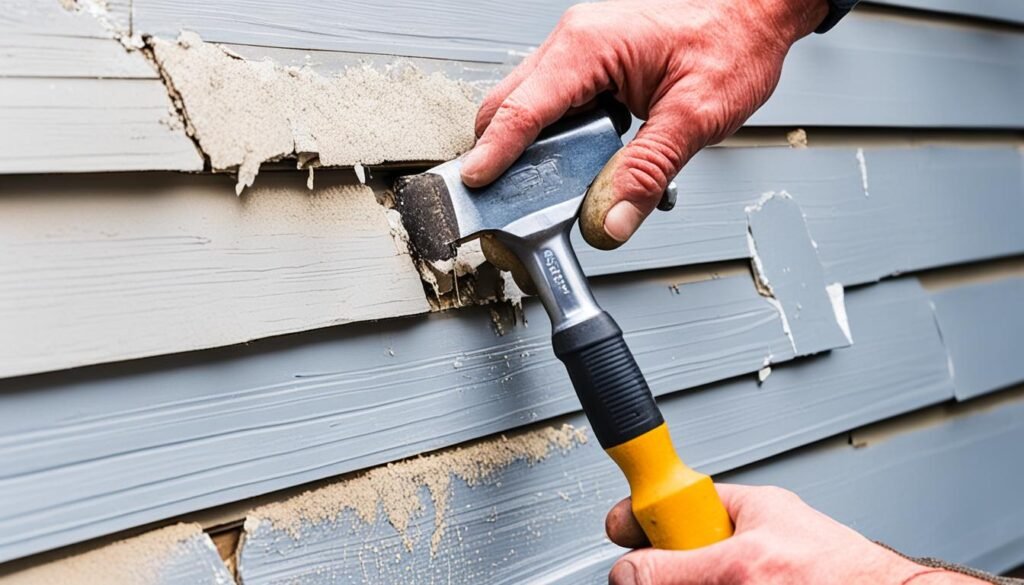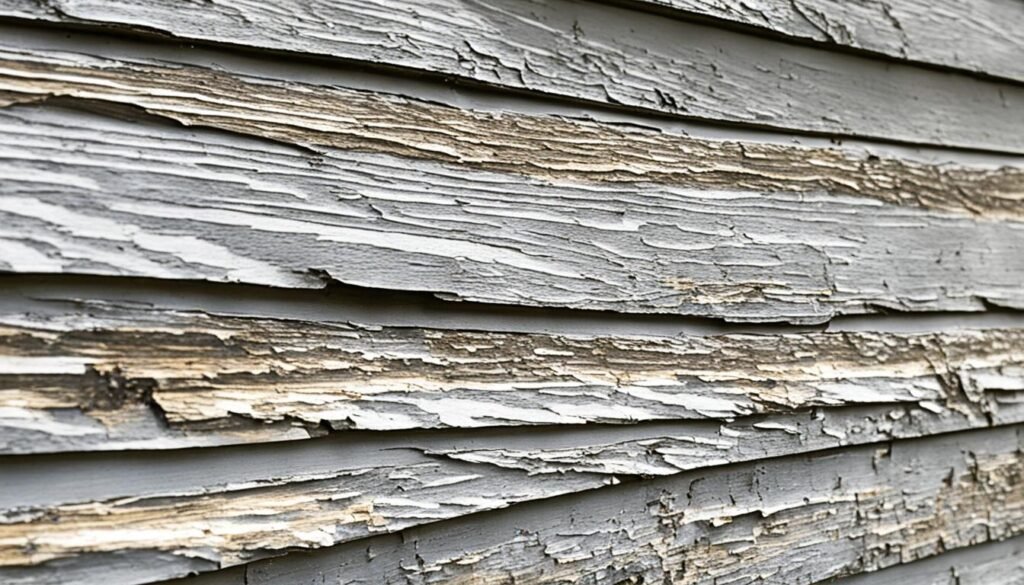Did you know water damage is a big problem for many homes in the U.S.? A recent study showed over 30% of homeowners have dealt with water damage to their siding. This can cost thousands to fix. If you’re facing this issue, don’t worry. This guide will help you fix water damaged siding and stop future problems.
Key Takeaways
- Water damaged siding can lead to more serious problems like structural damage and mold growth
- Identifying the signs of water damage and inspecting the underlying structure is crucial
- Repairing water damaged siding involves cleaning, replacing damaged materials, and waterproofing
- Hiring a professional siding contractor may be necessary for extensive damage
- Maintaining your siding through regular inspections and prompt repairs can prevent future water damage
Identifying and Assessing Water Damage on Siding
Spotting water damage on your home’s siding is the first step to fix it. Look closely at the outside to find affected areas and see how bad the damage is. This step is key to knowing what repairs are needed and to stop further damage.
Signs of Water Damaged Siding
Here are signs to watch for when checking for water damage on your siding:
- Blistering or peeling paint: Water can make the paint bubble and peel, showing the damaged siding below.
- Staining or discoloration: Water damage often leaves stains or color changes on the siding, showing moisture.
- Mold and mildew growth: Seeing mold or mildew means water has gotten in and there’s too much moisture.
- Warping or buckling: Long-term water exposure can warp, buckle, or change the shape of the siding.
- Rotting or decay: In bad cases, water damage can make the siding rot or decay, weakening it.
Inspecting the Underlying Structure
After seeing water damage on the siding, check what’s under it too. This means removing some damaged siding to see the framing, sheathing, and other parts. Look for:
- Moisture intrusion: Check for water or dampness in wall cavities, which could mean a bigger problem.
- Damaged framing: Inspect the wood framing for rot, decay, or damage that needs fixing before siding work.
- Compromised sheathing: Make sure the sheathing, like plywood or OSB, isn’t damaged or worn out from water.
Checking both the siding and what’s under it helps you understand the full damage. This lets you make a good plan for fixing it.
“Identifying and addressing water damage on your siding is crucial to maintaining the structural integrity and overall appearance of your home.”
How to Repair Water Damaged Siding
After finding and checking the water damage on your siding, it’s time to start fixing it. Fixing water-damaged siding is key to stopping more damage and keeping your home strong. We’ll show you how to repair water-damaged siding step by step. This includes important DIY repair tips and how to replace siding.
The first thing to do in siding repair techniques is to take out the damaged siding. Be careful not to harm the structure underneath. After removing the bad siding, look at the framing and sheathing for rot or moisture damage. Fix these issues before you start fixing the water damage.
- Carefully remove the damaged siding, taking care not to compromise the underlying structure.
- Inspect the framing and sheathing for any signs of rot or moisture-related problems, and address them accordingly.
- Install the replacement siding, ensuring a minimum overlap of 1 inch between the pieces.
- Secure the new siding in place using nails or screws.
- Apply a high-quality caulk and sealant to the seams and around the fasteners to prevent future water infiltration.
By following these steps, you can fix water damaged siding and make your home look good again. Remember, getting ready and paying attention to details is important for a lasting fix.

“Addressing water damage on siding is crucial for maintaining the structural integrity and curb appeal of your home. With the right techniques, you can effectively restore your siding and prevent further deterioration.”
Conclusion
By following these steps, you can fix water-damaged siding and make your home look great again. This guide has given you the tools and knowledge to handle this common issue. It covers everything from spotting water damage to fixing the structure.
If you’re not up for the repair yourself, think about getting help from a pro like FloodFixers. They provide top-notch siding repair and water damage restoration. This ensures your home’s exterior is fixed right, saving you money and boosting your home’s look.
Regular upkeep and quick action are crucial to keep your siding in good shape. By being careful and acting fast, you can keep your home’s exterior looking good for many years. Stay alert and take steps early to protect your home’s siding and avoid more damage.


